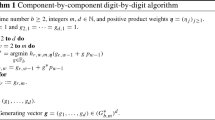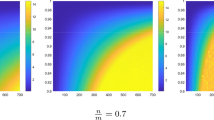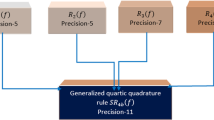Abstract
We show how to obtain a fast component-by-component construction algorithm for higher order polynomial lattice rules. Such rules are useful for multivariate quadrature of high-dimensional smooth functions over the unit cube as they achieve the near optimal order of convergence. The main problem addressed in this paper is to find an efficient way of computing the worst-case error. A general algorithm is presented and explicit expressions for base 2 are given. To obtain an efficient component-by-component construction algorithm we exploit the structure of the underlying cyclic group. We compare our new higher order multivariate quadrature rules to existing quadrature rules based on higher order digital nets by computing their worst-case error. These numerical results show that the higher order polynomial lattice rules improve upon the known constructions of quasi-Monte Carlo rules based on higher order digital nets.
Similar content being viewed by others
References
Baldeaux, J., Dick, J.: QMC rules of arbitrary high order: reproducing kernel Hilbert space approach. Constr. Approx. 30(3), 495–527 (2009)
Baldeaux, J., Dick, J., Greslehner, J., Pillichshammer, F.: Construction algorithms for higher order polynomial lattice rules. J. Complex. 27(3–4), 281–299 (2011)
Dick, J.: Higher order scrambled digital nets achieve the optimal rate of the root mean square error for smooth integrands. Ann. Stat. 39(3), 1372–1398 (2011)
Dick, J.: Explicit constructions of quasi-Monte Carlo rules for the numerical integration of high dimensional periodic functions. SIAM J. Numer. Anal. 45, 2141–2176 (2007)
Dick, J.: Walsh spaces containing smooth functions and quasi-Monte Carlo rules of arbitrary high order. SIAM J. Numer. Anal. 46(3), 1519–1553 (2008)
Dick, J.: The decay of the Walsh coefficients of smooth functions. Bull. Aust. Math. Soc. 80, 430–453 (2009)
Dick, J., Kritzer, P., Pillichshammer, F., Schmid, W.C.: On the existence of higher order polynomial lattices based on a generalized figure of merit. J. Complex. 23(4–6), 581–593 (2007)
Dick, J., Kuo, F.Y., Pillichshammer, F., Sloan, I.H.: Construction algorithms for polynomial lattice rules for multivariate integration. Math. Comput. 74(252), 1895–1921 (2005)
Dick, J., Pillichshammer, F.: Multivariate integration in weighted Hilbert spaces based on Walsh functions and weighted Sobolev spaces. J. Complex. 21(2), 149–195 (2005)
Dick, J., Pillichshammer, F.: Strong tractability of multivariate integration of arbitrary high order using digitally shifted polynomial lattice rules. J. Complex. 23(4–6), 436–453 (2007)
Dick, J., Pillichshammer, F.: Digital Nets and Sequences: Discrepancy Theory and Quasi-Monte Carlo Integration. Cambridge University Press, Cambridge (2010)
Korobov, N.M.: The approximate computation of multiple integrals/approximate evaluation of repeated integrals. Dokl. Akad. Nauk SSSR 124, 1207–1210 (1959) in Russian
Korobov, N.M.: Number-Theoretic Methods in Approximate Analysis. Goz. Izdat. Fiz.-Math (1963) in Russian
Larcher, G., Lauss, A., Niederreiter, H., Schmid, W.C.: Optimal polynomials for (t, m, s)-nets and numerical integration of multivariate Walsh series. SIAM J. Numer. Anal. 33(6), 2239–2253 (1996)
Niederreiter, H.: Random Number Generation and Quasi-Monte Carlo Methods, no. 63. Regional Conference Series in Applied Mathematics. SIAM (1992)
Novak, E., Woźniakowski, H.: Tractability of Multivariate Problems—vol. I: Linear Information. EMS Tracts in Mathematics, vol. 6. European Mathematical Society Publishing House (2008)
Novak, E., Woźniakowski, H.: Tractability of Multivariate Problems—vol. II: Standard Information for Functionals. EMS Tracts in Mathematics, vol. 12. European Mathematical Society Publishing House (2010)
Nussbaumer, H.J.: Fast Fourier Transform and Convolution Algorithms, 2nd edn. Springer-Verlag (1982)
Nuyens, D.: Fast construction of good lattice rules. Ph.D. Thesis, Dept. of Computer Science, K. U. Leuven (2007)
Nuyens, D., Cools, R.: Fast algorithms for component-by-component construction of rank-1 lattice rules in shift-invariant reproducing kernel Hilbert spaces. Math. Comput. 75(254), 903–920 (2006)
Nuyens, D., Cools, R.: Fast component-by-component construction, a reprise for different kernels. In: Niederreiter, H., Talay, D. (eds.) Monte Carlo and Quasi-Monte Carlo Methods 2004, pp. 371–385. Springer-Verlag (2006)
Owen, A.B.: Monte Carlo variance of scrambled net quadrature. SIAM J. Numer. Anal. 34(5), 1884–1910 (1997)
Pirsic, G.: A software implementation of Niederreiter–Xing sequences. In: Fang, K.T., Hickernell, F.J., Niederreiter, H. (eds.) Monte Carlo and Quasi-Monte Carlo Methods 2000, pp. 434–445. Springer-Verlag (2002)
Schmid, W.C.: Improvements and extensions of the “Salzburg Tables” by using irreducible polynomials. In: Niederreiter, H., Spanier, J. (eds.) Monte Carlo and Quasi-Monte Carlo Methods 1998, pp. 436–447. Springer, Berlin (2000)
Sloan, I.H., Reztsov, A.V.: Component-by-component construction of good lattice rules. Math. Comput. 71(237), 263–273 (2002)
Sloan, I.H., Woźniakowski, H.: When are quasi-Monte Carlo algorithms efficient for high dimensional integrals? J. Complex. 14(1), 1–33 (1998)
Stahnke, W.: Primitive binary polynomials. Math. Comput. 27(124), 977–980 (1973)
Šarygin, I.F.: Lower bounds for the error of quadrature formulas on classes of functions. USSR Comput. Math. Math. Phys. 3, 489–497 (1965); Translation from Russian Zh. Vychisl. Mat. Mat. Fiz. 3, 370–376 (1963)
Author information
Authors and Affiliations
Corresponding author
Additional information
Josef Dick is supported by a Queen Elizabeth 2 Fellowship from the Australian Research Council.
Gunther Leobacher is partially supported by the Austrian Science Foundation (FWF), Project P21196.
Dirk Nuyens is a postdoctoral fellow of the Research Foundation Flanders (FWO).
Friedrich Pillichshammer is partially supported by the Austrian Science Foundation (FWF), Project S9609, that is part of the Austrian National Research Network “Analytic Combinatorics and Probabilistic Number Theory”.
Rights and permissions
About this article
Cite this article
Baldeaux, J., Dick, J., Leobacher, G. et al. Efficient calculation of the worst-case error and (fast) component-by-component construction of higher order polynomial lattice rules. Numer Algor 59, 403–431 (2012). https://doi.org/10.1007/s11075-011-9497-y
Received:
Accepted:
Published:
Issue Date:
DOI: https://doi.org/10.1007/s11075-011-9497-y




